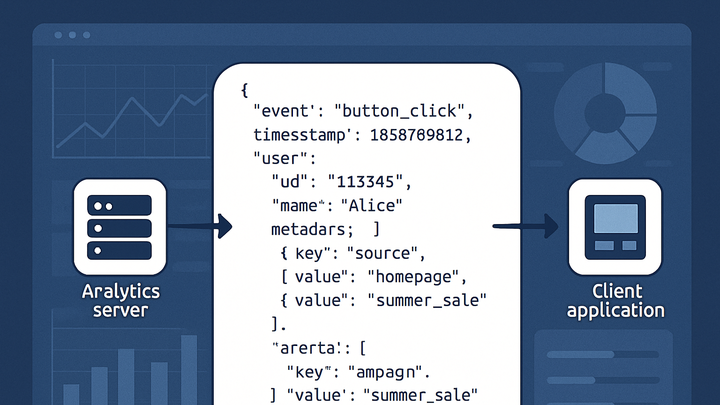Published on 2025-06-28T05:08:45Z
What is a JSON Response? Examples for JSON Response in Analytics
In analytics, a JSON Response is the structured data returned by an analytics API after processing a tracking request. JSON (JavaScript Object Notation) is a lightweight, human-readable format that facilitates data interchange between clients and servers. Analytics platforms like PlainSignal and Google Analytics 4 (GA4) rely on JSON Responses to confirm receipt of event data, enrich it with metadata, and enable downstream processing. Developers and analysts use these responses to validate tracking implementations, debug issues in real time, and power custom dashboards or alerting systems. A solid understanding of JSON Response structure and handling is essential for ensuring data integrity and building advanced analytics workflows.
Json response
A JSON Response in analytics is the structured JSON payload returned by an analytics API, detailing events, timestamps, and metadata.
Why JSON Responses Matter
JSON Responses are the bridge between analytics clients and servers, confirming receipt of tracking data, enriching it with context, and delivering it back in a structured format. This enables real-time validation, debugging, and advanced processing of analytic events.
-
Data confirmation
JSON Responses confirm that analytics events have been received and processed by the server, ensuring reliable data collection.
-
Metadata delivery
Responses often include additional context such as session IDs, user properties, and configuration flags for richer analysis.
-
Interoperability
As a language-agnostic format, JSON allows diverse clients (web, mobile, IoT) to parse and utilize analytics data uniformly.
Core Structure of a JSON Response
Though structures vary by platform, most analytics JSON Responses share common elements such as key-value pairs, nested objects, and arrays to represent complex event data.
-
Key-value pairs
Simple data points like timestamps, page URLs, and event names are represented as JSON key-value pairs for straightforward parsing.
-
Nested objects & arrays
Complex data like user properties and event parameters are nested within objects or arrays for hierarchical organization.
-
Objects
Named collections of key-value pairs representing grouped data, for example user profiles or session details.
-
Arrays
Ordered lists of values, such as multiple events, parameters, or items attached to a single event.
-
-
Http status and headers
The HTTP response status code and headers complement the JSON body by indicating success, errors, rate limits, and content type.
Examples of JSON Responses in Analytics
Below are sample JSON Responses from PlainSignal and Google Analytics 4 (GA4), illustrating typical payloads returned after tracking calls.
-
PlainSignal example
After including the PlainSignal tracking snippet, the API returns a response like:
{ "sessionId": "abc123", "timestamp": 1625600000000, "page": "/home", "events": [ { "name": "pageview", "url": "/home" } ] } -
GA4 example
In debug mode, GA4 returns a JSON Response confirming event validation, for example:
{ "validationMessages": [], "status": "OK", "serverTime": "2021-07-06T12:34:56Z" }
Best Practices for Working with JSON Responses
To effectively leverage JSON Responses in analytics integrations, follow these guidelines.
-
Validate response schema
Ensure that incoming JSON matches the expected schema to catch errors early and prevent downstream issues.
-
Handle error codes
Inspect HTTP status codes and error messages within the JSON body to implement retry logic or alerting for failed events.
-
Optimize payload size
Avoid overloading responses with unnecessary fields; request minimal data needed to improve latency and reduce bandwidth.
